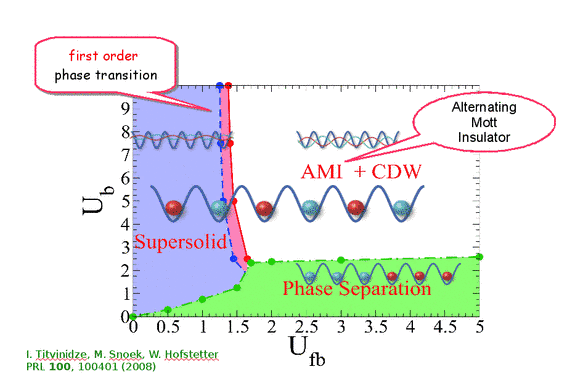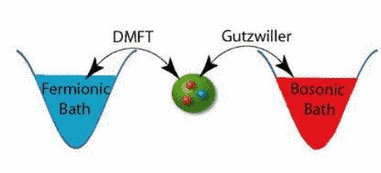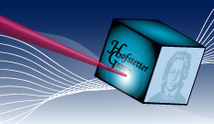Bose-Fermi Mixtures
Ultracold atomic gases provide a very powerful tool to study prototypical model of condensed matter like the Hubbard model.On the other hand what is often less understood is that they also provide the possibility of studying systems or regime which have no analogous in condensed matter or simply are experimentally hardly accessible. In particular, one can perform experiments on Bose-Fermi mixtures with a large degree of tunability in the interaction, polarization, etc. In some extreme regimes these mixtures can be viewed as analogous to electronic systems in presence of phonons, but in general this analogy does not work and we have to consider these mixtures as novel quantum systems.
One of the key questions that has been explored is the effect of fermions on the mobility of the bosons. When fermions are slow compared to the bosons,they act as dynamical impurities. Fast fermions, on the other hand, mediate long-range interactions between the bosons. In both cases this has an effecton the superfluid-Mott insulator transition [1]. Another interesting theme is also the possibility of having a supersolid phase for commensurate filling of the fermions. This topic has been widely investigated [2] [3] in our group using the so called Generalized-DMFT (G-DMFT). These mixtures of fermions and bosons in optical lattices are welldescribed by the Bose-Fermi Hubbard model whose Hamiltonian reads
 |
|
|
To describe such model one has to generalize DMFT and include also bosonic degrees of freedom [2] [3] . Also the bosonic hopping have to be rescaled to ensure a meaningful limit in infinite dimension and keep the kinetic energy per lattice site finite. Following the same steps of the usual DMFT (See DMFT in the section methods and reference therein) it's easy to realize that in this limit the bosonic part corresponds exactly to the Gutzwiller approximation, whereas the fermionic part corresponds to the DMFT. This derivation shows that the Gutzwiller approximation for bosons is exact in infinite dimensions, and, like the DMFT, valid for arbitrary couplings in the Hamiltonian. Therefore G-DMFT amounts essentially to combine Gutzwiller approach with DMFT considering that both the approaches are exact respectively for Bosonic and Fermionic degrees of freedom in infinite dimensions
 |
GDMFT was used to study mixtures of commensurate filled bosons and spinless fermions, i.e. not interacting directly with each other. This spinless fermions case corresponds to put in your system only a single hyperfine state of a fermionic species.
The main result is that the ground state of the system is a supersolid in some region of the space of parameters. A supersolid is a phase density modulations on a microscopic scale (CDW) is coexisting with superfluid properties. With reference to the figure aside it's evident that, in the regime with strong bosonic repulsion, a supersolid phase takes place for weak interaction between the two species, while a alternating Mott insulator phase (where fermions and bosons are localized in different sublattices) is realized for stronger Bose-Fermi interaction. These phases are separated by a first order transition. For weak interactions among the bosons, the half-filled state is unstable towards Phase Separation.
References:
[1] T. Best et al., Phys. Rev. Lett. 102, 030408 (2009)
[2] I. Titvinidze et al. , Phys. Rev. Lett. 100, 100401 (2008)
[3] I. Titvinidze et al. , Phys. Rev. B 79, 144506 (2009)






